Solved Examples
1. Two boys, one 52 inches tall and the other 55 inches tall, are standing at distance 4.0 m and
5.0 m respectively from an eye. Which boy will appear taller?
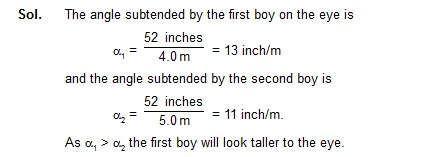
2. A compound microscope has an objective of focal length 1 cm and an eyepiece of focal length
2.5 cm. An object has to be placed at a distance of 1.2 cm away from the objective for normal adjustment, (a) Find the angular magnification. (b) Find the length of the microscope tube.
Sol. (a) If the first image is formed at a distance v from the objective, we have

(b) For normal adjustment, the first image must be in the focal plane of the eyepiece.
The length of the tube is, therefore,
L = v + fc = 6 cm + 2.5 cm = 8.5 cm.
3. A nearsighted man can clearly see objects up to a distance of 1.5 m. Calculate the power of the lens of the spectacles necessary for the remedy of this defect.
Sol. The lens should form a virtual image of a distant object at 1.5 m from the lens. Thus, it should be divergent lens and its focal length should be 1.5 m.
Hence,
f = – 1.5 m
or, P = 1/f = – 1/1.5 m–1 = – 0.67 D.
Questions for Short answer
1. Can virtual image be formed on the retina in a seeing process?
2. Can the image formed by a simple microscope be projected on a screen without using any additional lens or mirror?
3. The angular magnification of a system is less than one. Does it mean that the image formed is inverted?
4. A simple microscope using a single lens often shows coloured image of a white source. Why?
5. A magnifying glass is a converging lens placed close to the eye. A farsighted person uses spectacles having converging lenses. Compare the functions of a converging lens used as a magnifying glass and as spectacles.
6. A person is viewing an extended object. If a converging lens is placed in front of his eyes, will he feel that the size has increased?
7. The magnifying power of a converging lens used as a simple microscope is (1+D/f) . A compound microscope is a combination of two such converging lenses. Why don’t we have magnifying power (1+D/f0) (1+D/fe) ? In other words, why can the objective not be treated as a simple microscope but the eyepiece can?
8. By mistake, an eye surgeon puts a concave lens in place of the lens in the eye after a cataract operation. Will the patient be able to see clearly any object placed at any distance?
9. The magnifying power of a simple microscope is given by 1 +D/f , where D is the least distance for clear vision. For farsighted persons, D is greater than the usual. Does it mean that the magnifying power of a simple microscope is greater for a farsighted per as compared to a normal person? Does it mean that a farsighted person can see an insect more clearly under a microscope than a normal person?
10. Why are the magnification properties of microscope and telescope defined in terms of the ratio of the angles and not in terms of the ratio of size of objects and images?
11. An object is placed at a distance of 30 cm from a converging lens of focal length 15 cm. A normal eye (near point 25 cm, far point infinity) is placed close to the lens on the other side. (a) Can the eye see the object clearly ? (b) What should be the minimum separation between the lens and the eye so that the eye can clearly see the object? (c) Can a diverging lens, placed in a contact with the converging lens, help in seeing the object clearly when the eye is close to the lens?
12. A compound microscope form an inverted image of an object. In which of the following cases it is likely to create difficulties? (a) Looking at small germs. (b) Looking at circular spots. (c) Looking at a vertical tube containing some water.
Objective - I
1. The size of an object as perceived by an eye depends primarily on
(A) actual size of the object (B) distance of the object from the eye
(C) aperture of the pupil (D) size of the image formed on the retina
2. The muscles of a normal eye are least strained when the eye is focused on an object
(A) far away from on an object (B) very close to the eye
(C) at about 25 cm from the eye (D) at about 1 m from the eye
3. A normal eye is not able to see objects closer than 25 cm because
(A) the focal length of the eye is 25 cm
(B) the distance of the retina from the eye-lens is 25 cm
(C) the eye is not able to decrease the distance between the eye-lens and the retina beyond a limit
(D) the eye is not able to decrease the focal length beyond a limit
4. When objects at different distance are seen by the eye, which of the following remain constant?
(A) The focal length of the eye-lens (B) The object-distance from the eye-lens
(C) The radii of curvature of the eye-lens (D) The image-distance from the eye-lens
5. A person A can clearly see objects between 25 cm and 200 cm. Which of the following may represent the range of clear vision for a person B having muscles stronger than A, but all other parameters of eye identical to that of A?
(A) 25 cm to 200 cm (B) 18 cm to 200 cm
(C) 25 cm to 300 cm (D) 18 cm to 300 cm
6. The focal length of a normal of eye-lens is about
(A) 1 feeh (B*) 2 lseh (C) 25 lseh (D) 1 eh
7. The distance of the eye-lens from the retina is x. For a normal eye, the maximum focal length of the eye-lens
(A) = x (B) < x (C) > x (D) = 2 x
8. A man wearing glasses of focal length +1 m cannot clearly see beyond 1 m
(A) if he is farsighted (B) if he is nearsighted
(C) if his vision is normal (D) in each of these cases
9. An object is placed at a distance u from a simple microscope of focal length f. The angular magnification obtained depends
(A) on f but not on u (B) on u but not on f
(C) on f as well as u (D) neither on f nor on u
10. To increase the angular magnification of a simple microscope, one should increase
(A) the focal length of the lens (B) the power of the lens
(C) the aperture of the lens (D) the object size
11. A man is looking at a small object placed at his near point. Without altering the position of his eye or the object, he puts a simple microscope of magnifying power 5X before his eyes. The angular magnification achieved is -
(A) 5 (B) 2.5 (C*) 1 (D) 0.2
Objective - II
1. When we see an object, the image fromed on the retina is -
(A) real (B) virtual (C) erect (D) inverted
2. In which of the following the final image is erect?
(A) Simple microscope (B) Compound microscope
(C) Astronomical telescope (D) Galilean telescope
3. The maximum focal length of the eye-lens of a person is greater than its distance from the retina. The eye is
(A) always strained in looking at an object (B) strained for objects at large distances only
(C) strained for objects at short distances only (D) unstrained for all distances.
4. Mark the correct options -
(A) If the far point goes ahead, the power of the divergent lens should be reduced
(B) If the near point goes ahead, the power of the convergent lens should be reduced
(C) If the far point is 1 m away from the eye, divergent lens should be used
(D) If the near point is 1 m away from the eye, divergent lens should be used.
5. The focal length of the objective of a compound microscope is fo and its distance from the eyepiece is L. The object is placed at a distance u from the objective. For proper working of the instrument.
(A) L > u (B*) L > u (C) fO < l < 2fO (D) L > 2f0.
Worked Out Examples
1. An object is seen through a simple microscope of focal length 12 cm. Find the angular magnification produced if the image is formed at the near point of the eye which is 25 cm away from it.
Sol. The angular magnification produced by a simple microscope when the image is formed at the near point of the eye is given by
m = 1 + D/f.
Here f = 12 cm, D = 25 cm.
Hence,
m = 1 + 25/12 = 3.08,
2. A 10 D lens is used as a magnifier. Where should the object be placed to obtain maximum angular magnification for a normal eye (near point = 25 cm)?
Sol. Maximum angular magnification is achieved when the final image is formed at the near point. Thus,
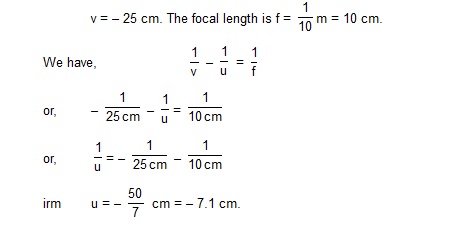
3. A small object is placed at a distance of 3.6 cm from a magnifier of focal length 4.0 cm. (a) Find the position of the image. (b) Find the linear magnification. (c) Find the angular magnification
(c) If the object is placed at a distance u0 from the lens, the angel subtended by the object on the lens is  where h is the height of the object. The maximum angle subtended on the unaided eye is .
where h is the height of the object. The maximum angle subtended on the unaided eye is .


4. A compound microscope consists of an objective of focal length 1.0 cm and an eyepiece of focal length 5.0 cm separated by 12.2 cm. (a) At what distance from the objective should an object be placed to focus it properly so that the final image is formed at the least distance of clear vision (25 cm)? (b) Calculate the angular magnification in this case.
Sol.(a) For the eyepiece, ve = – 25 cm and fe = + 5 cm.
Using 1/ve – 1/ue = 1/fe,
1/ve =1/ue – 1/fe , = –1/25cm – 1/5cm
or, ue = – 25/6 cm = – 4.17 cm = – 4.2 cm
As the objective is 12.2 cm away from the eyepiece, the image formed by the objective is
12.2 cm – 4.2 cm = 8.0 cm away from it. For the objective,
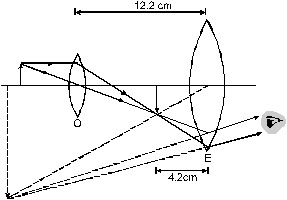
v = + 8.0 cm, f0 = + 1.0 cm
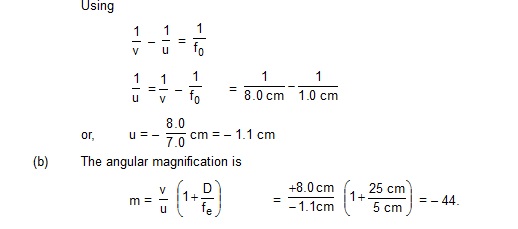
5. The separation L between the objective (f = 0.5 cm) and the eyepiece (f = 5 cm) of a compound microscope is 7 cm. Where should a small object be placed so that the eye is least strained to see the image? Find the angular magnification produce by the microscope.
Sol. The eye is least strained if the final image is formed at infinity. In such a case, the image formed by the objective should fall at the focus ofthe eyepiece. As fe = 5 cm and L = 7 cm, this first image should be formatted 7 cm – 5 cm = 2 cm from the objective. Thus v = + 2 cm. Also, fe = 0.5 cm. For the objective, using
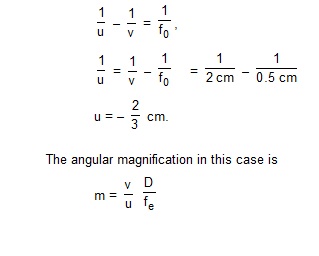
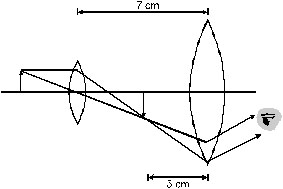
6. An astronomical telescope has an objective of focal length 200 cm and an eyepiece of focal length 4.0 cm. The telescope is focused to see an object 10 km from the objective. The final image is formed at infinity. Find the length of the tube and the angular magnification produced by the telescope.
Sol. As the object distance 10 km is much larger than the focal length 200 cm, the first image is formed almost at the focus of the objective. It is thus 200 cm from the objective. It is thus 200 cm from the objective. This image acts as the objective for the eyepiece. To get the final image at infinity, this first image should be at the first focus of the eyepiece. The length of the tube is, therefore, 200 cm + 4 cm = 204 cm. The angular magnification in this case
m = –f0/fe = –200/4 = – 50.
7. A Galilean telescope is constructed by an objective of focal length 50 cm and an eyepiece of focal length 5.0 cm. (a) Find the tube length and magnifying power when it is used to see an object at a large distance in normal adjustment. (b) If the telescope is to focus an object 2.0 m away from the objective, what should be the tube length an angular magnification, the image again forming at infinity?
Sol. fo = 50 cm, fe = 5 cm.
(a) L = f0 | fe| = (50 – 5) cm = 45 cm
and m = f0/fe = 50/5 = 10.
(b) Using the equation 1/v – 1/u = 1/f for the objective,
1/v = 1/f + 1/u = 1/50cm + 1/-200cm
or, v = 66.67 cm.
The tube length L = v – | fe | = (66.67 – 5) cm
or, L = 61.67 cm.
To calculate the angular magnification, we assume that the object remains at large distance from the eye. In this case, the angular magnification
m = v/fe = 66.67/5 = 13.33
v is the distance of the first image from the objective which is substituted for f0.
8. The image of the moon is focused by a converging lens of focal length 50 cm on a plane screen. The image is seen by an unaided eye from a distance of 25 cm. Find the angular magnification achieved due to the converging lens.
Sol. 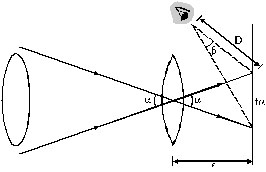
Suppose the moon subtends an angle a on the lens. This will also be the angle subtends by the moon on the eye if the moon is directly viewed. The image is formed in the focal plane. The linear size of the image = f x alpha = (50cm )alpha
If this image is seen from a distance of 25 cm, the angle formed by the image on the eye

9. The near and far point of a person are at 40 cm and 250 cm respectively. Find the power of the lens he/she should use while reading at 25 cm. With this lens on the eye, what maximum distance is clearly visible?
Sol. If an object is placed at 25 cm from the correcting lens, it should produce the virtual image at 40 cm. Thus, u = – 25 cm, v = – 40 cm.
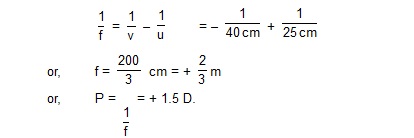
The unaided eye can see a maximum distance of 250 cm. Suppose the maximum distance for clear vision is d when the lens is used. Then the object at a distance d is imaged by the lens at 250 cm. We have

Thus, the person will be able to see upto a maximum distance of 53 cm.
10. A young boy can adjust the power of his eye-lens between 50 D and 60 D. His far point is infinity. (a) What is the distance of his retina from the eye-lens? (b) What is his near point?
Sol.(a) When the eye is fully relaxed, its focal length is largest and the power of the eye-lens is minimum. This power is 50 D according to the given data. The focal length is 1/50m = 2 cm. As the far point is at infinity, the parallel rays relaxed condition. Hence, the distance of the retina from the lens equals the focal length which is 2 cm.
(b) When the eye is focused at the near point, the power is maximum which is 60 D. The focal length in this case

Exercise
1. A person looks at different trees in an open space with the following details. Arrange the trees in decreasing order of their apparent sizes.
Tree Height (m) Distance from the eye (m)
A 2.0 50
B 2.5 80
C 1.8 70
D 2.8 100
Ans. A, B, C, D
2. An object is to be seen through a simple microscope of focal length 12 cm. Where should the object be places so as to produce maximum angular magnification? The least distance of clear vision is 25 cm.
Ans. 8.1 cm from the lens
3. A simple microscope has a magnifying power of 3.0 when the image is formed at the near point (25 cm) of a normal eye. (a) What is its focal length ? (b) What will be its magnifying power if the image is formed at infinity?
Ans. (a) 12.5 cm (b) 2.0
4. A child has near point at 10 cm. What is the maximum angular magnification the child can have with a convex lens of focal length 10 cm?
Ans. 2
5. A simple microscope is rated 5 X for a normal relaxed eye. What will be its magnifying power for a relaxed farsighted eye whose near point is 40 cm?
Ans. 8 X
6. Find the maximum magnifying power of a compound microscope having a 25 diopter lens as the objective, a 5 diopter lens as the eyepiece and the separation 30 cm between the two lenses. The least distance for clear vision is 25 cm.
Ans. 8.4
7. The separation between the objective and the eyepiece of a compound microscope can be adjusted between 9.8 cm to 11.8 cm. If the focal lengths of the objective and the eyepiece are 1.0 cm and 6 cm respectively, find the range of the magnifying power if the image is always needed at 24 cm form the eye.
Ans. 20 to 30
8. An eye can distinguish between two points of an object if they are separated by more than 0.22 mm when the object is placed at 25 cm from the eye. The object is now seen by a compound microscope having a 20 D having objective and 10 D eyepiece separated by a distance of 20 cm. The final image is formed at 25 cm from the eye. What is the minimum separation between two points of the object which can now be distinguished?
Ans. 0.04 mm
9. A compound microscope has a magnifying power of 100 when the image is formed at infinitely. The objective has a focal length of 0.5 cm and the tube length is 6.5 cm. Find the focal length of the eyepiece.
Ans. 2 cm
10. A compound microscope consists of an objective of focal length 1 cm and an eyepiece of focal length 5 cm. An object is placed at a distance of 0.5 cm from the objective. What should be the separation between the lenses os that the microscope projects an inverted real image of the object on a screen 30 cm behind the eyepiece?
Ans. 5 cm
11. An optical instrument used for angular magnification has a 25 D objective and a 20 D eyepiece. The tube length is 25 cm when the eye is least strained (a) Whether it is a microscope or a telescope? (b) What is the angular magnification produced?
Ans. microscope, 20
12. An astronomical telescope is to be designed to have magnifying power of 50 in normal adjustment. If the length of the tube is 102 cm, find the powers of the objective and the eyepiece.
Ans. 1 D, 50 D
13. The eyepiece of an astronomical telescope has a focal length of 10 cm. The telescope is focused for normal vision of distant objective when the tube length is 1.0 cm. Find the focal length of the objective and the magnifying power of the telescope.
Ans. 90 m, 9
14. A Galilean telescope is 27 cm long when focused to form an image at infinity. If the objective has a focal length of 30 cm, what is the focal length of the eyepiece?
Ans. 3 cm
51. A farsighted person cannot see objects placed closer to 50 cm. find the power of the lens needed to see the objects at 20 cm.
Ans. 3 D
16. A nearsighted person cannot clearly see beyond 200cm. Find the power of the lens needed to see objects at large distances.
Ans. – 0.5 D
17. A person wears glasses of power – 2.5 D. Is the person farsighted or nearsighted? What is the far point of the person without the glasses?
Ans. nearsighted, 40 cm
18. A professor reads a greeting car received on his 50 th birthday with + 2.5 D glasses keeping the card 25 cm away. Ten years later, he reads his farewell letter with the same glasses but he has to keep the letter 50 cm away. What power of lens should he now use?
Ans. + 4.5 D
19. A normal eye has retina 2 cm behind the eye-lens. What is the power of the eye-lens when the eye is (a) fully relaxed, (b) most strained?
Ans. 50 D, 54 D
20. The near point and the far point of a child are at 10 cm and 100 cm. If the retina is 2.0 cm behind the eye-lens, what is the range of the power of the eye-lens?
Ans. + 60 D to + 51 D
21. A nearsighted person cannot see beyond 25 cm. Assuming that the separation of the glass from the eye is 1 cm, find the power of lens needed to see distant objects.
Ans. – 4.2 D
22. A person has near point at 100 cm. What power of lens is needed to read at 20 cm if he/she uses (a) contact lens, (b) spectacles having glasses 2.0 cm separated form the eyes?
Ans. + 4 D, 4.53 D
23. A lady uses + 1.5 D glass to have normal vision from 25 cm onwards. She uses a 20 D lens as a simple microscope to see an object. Find the maximum magnifying to see an object. Find the maximum magnifying power if she was uses to microscope (a) together with her glass (b) without the glass. Do the answers suggest that an object can be more clearly seen through a microscope without using the correcting glasses?
Ans. 6, 9
24. A lady cannot see objects closer than 40 cm from the left eye and closer than 100 cm from the right eye. While on a mountaineering trip, she is lost from her team. She tries to make an astronomial telescope from her reading glasses to look for her teammates. (a) Which glass should she use as the eyepiece? (b) What magnification can she get with relaxed eye?
Ans. right lens, 2